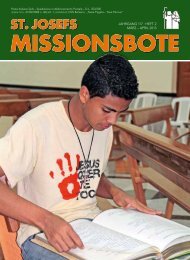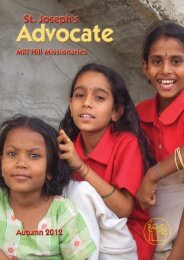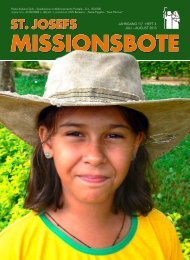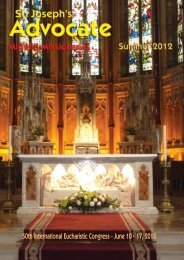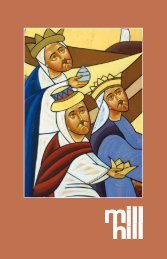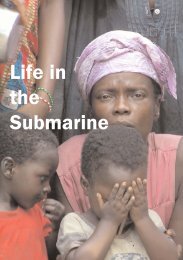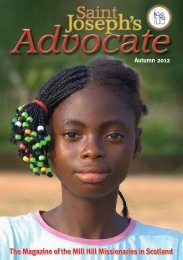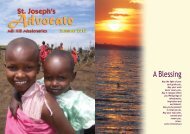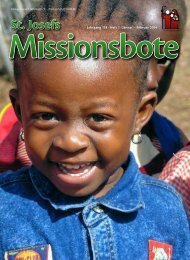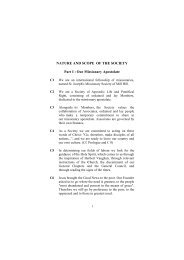Summer 2012 [pdf] - The Mill Hill Missionaries
Summer 2012 [pdf] - The Mill Hill Missionaries
Summer 2012 [pdf] - The Mill Hill Missionaries
You also want an ePaper? Increase the reach of your titles
YUMPU automatically turns print PDFs into web optimized ePapers that Google loves.
2<strong>Summer</strong> <strong>2012</strong>
From His wounded side flowed blood and water,the fountain of sacramental life in the Church.To His open heart the Saviour invites all men todraw water in joy from the springs of salvation.From the preface of the Mass of the Sacred Heart.ContentsPage 3 Editorial.Page 5 Sixty Years a Missionary.Page 9 Return to the Congo.Page 12 Missionary from the Gorbals.Page 14 Opening the Door of Faith.Page 16 Let’s have a Coffee.Page 19 Dark Thursday - Fr Declan,martyr for peace.Page 23 <strong>Mill</strong> <strong>Hill</strong> News.Page 24 Silver Circle Winners.Page 25 ObituariesPage 26 Wisdom of the Peoples ofthe Forest.AcknowledgmentsContributors:Bishop Colin Davies mhmFr Jim Fanning mhmFr Piet Korse mhmFr Gerry Hastie mhmIta O’ConorPhoto Credits:Fr Fons Eppink mhmMH ArchivesCover photos:Front cover: Church celebration,Kenya.Inside front cover: Window ofSacred Heart Chapel,St Joseph’s College, <strong>Mill</strong> <strong>Hill</strong>Back cover: Young man, Kotido.St. Joseph’s Advocateis the magazine of the <strong>Mill</strong> <strong>Hill</strong> <strong>Missionaries</strong> inScotland, published from St. Joseph’s House,30 Lourdes Avenue, Cardonald,Glasgow G52 3QU.Tel: 0141 883 0139.Email: tollanmhm@yahoo.co.ukRegistered Charity Number: SCO39809Produced by:Burns Morrison Print Management Ltd.,Caledonia Business Centre,Thornliebank Industrial Estate, Glasgow G46 8JTTel: 07799 645 420Email: sales@burnsmorrison.co.ukFr. Bill Tollan m h m ,EditorEditorialRekindlingthe Fireof Faith<strong>The</strong> American Jesuit Fr John Kavanaughtold of meeting Mother Teresa. “I hadasked her to pray for me. She said, ‘Forwhat?’ ‘For clarity,’ I pled. And sheimmediately said no, she would not prayfor that. I complained that she seemedalways to have clarity and certitude. ‘I’venever had clarity and certitude,’ she said.‘I only have trust. I’ll pray that youtrust.’”We would all like to have clarity andcertitude in our lives. We imagine thatif we really had ‘faith’ all our problemswould be solved. But that’s not really whatFaith is all about. Faith is a gift we receivedin Baptism, but it’s a gift that we have tolearn to use, a gift to be exercised. We livein a place and at a time of dwindling faith;23
we imagine that in former times,in the ‘Ages of Faith’, it must havebeen easier to be a Christian. ButFaith has always been a challenge toChristians. “<strong>The</strong> believer is alwaysthreatened with uncertainty”wrote the young Joseph Ratzingerin an early work.Pope Benedict hasannounced a ‘Yearof Faith’, to beginin October this year.In an ApostolicLetter (‘Porta Fidei’,available from theCTS) he writes,“From the startof my ministry asSuccessor of Peter, Ihave spoken of theneed to rediscoverthe journey offaith.” Faith is notsomething static,but something thatis ongoing. We need the experienceof what the Holy Father calls ‘goingto the well’ (like the Samaritanwoman) “in order to hear Jesus,who invites us to believe in himand to draw upon the source ofliving water within him ...We mustrediscover the taste for feedingourselves on the word of God ...and on the bread of life...”“<strong>The</strong> true essence of Christianity“<strong>The</strong> trueessence ofChristianity isa love storybetween Godand humanbeings”is a love story between God andhuman beings” said CardinalRatzinger in 2004. He went on,“If one could only understandthis in the language of today,everything else would follow.” AsPope Benedict, in 2006 he said, “...knowing God is notenough ...knowledgemust become love.”Deepening andrevitalising our Faithis not just knowingmore about ourbeliefs; rather, it’sabout falling in loveonce again withour Beloved Lord.“Faith grows whenit is lived as anexperience of lovereceived and whenit is communicatedas an experience ofgrace and joy.”This is the Faith that underliesand inspires the missionary workof the Church. In this issue ofthe ‘Advocate’ there are manyexamples of faith in action, fromFr Crumblish in India, to BishopColin Davies in Kenya, to Fr JimFanning in the Congo, - and to thelate Fr Declan O’Toole in Uganda.May this Year of Faith awaken inus all a renewed and ferventmissionary spirit.Sixty Years aMissionaryOn the occasion of my celebrationof 60 years as a Priest and a <strong>Mill</strong> <strong>Hill</strong>Missionary I have been asked to writeup an account of my life. It wouldbe my wish through this biographyto encourage others to follow inmy footsteps and be open to a callfrom Christ to share the happinessof following Him, that others might“have life and have it abundantly.”At my present age of 87 and after avery eventful life, it is quite difficult toknow what to write about, but I willdo my best.Parish Church, Ngong.by Bishop Colin Davies MHM OBEEarly YearsI was born in the Canary Islands(Spain), on 10th June 1924, andmoved to Madrid in 1926. In 1931,aged 7, my family settled in Argentina,which is my home country. I havelived in England for some 12 years,and in Kenya for 52 years. I was thethird-born of a family of three boysand three girls, and went to an Englishschool in Argentina, where I passedthe Cambridge School Certificate. Myfather was not able to send any of us toUniversity but that did not make any4 5
ordained to the Priesthood on 13th July1952. Having changed to a MissionarySociety to go out to the Missions, I waskept back and appointed to teach in a<strong>Mill</strong> <strong>Hill</strong> College in England for sevenyears. Having reluctantly accepted theappointment, I found out God knewbetter than I did. I learned much,enjoyed my work, and strengthenedthe basis of my spiritual formation.Mission AppointmentIn July 1959 I got an appointment toan entirely new mission among theMaasai in Kenya. <strong>Mill</strong> <strong>Hill</strong> had beenasked to begin from scratch in some15,000 sq. Miles of Maasailand. <strong>The</strong>rewere four of us, with Mgr Jan de Reepermhm as the first Prefect Apostolic.Imagine that by June 1st 1960 I wassent alone to begin evangelising thewhole of Kakiado District, some 7,000sq. Miles...all to myself! I worked inthis area for four years, until I wasappointed successor to Mgr de Reeperon July 22nd 1964. In December 1976I was named first Bishop of the newDiocese of Ngong, and continued assuch until January 2003 when mysuccessor was consecrated.<strong>The</strong> highlights of those years were myattending Vatican Council II in 1964and 1965 as a “Council Father.” Whoin my school days could have imaginedme as a Council Father, let alone aBishop! A God of Surprises! <strong>The</strong>n therewas the African Synod of 1994. “WithGod all things are possible.”Some statisticsIn January 1960, in the wholePrefecture, there were four priests, onePrefect Apostolic, one Parish, about1,000 Catholics, 5 Primary Schools, andabout 7 out-stations. When I handedover in 2003 there were 64 priests, oneBishop, about 80 Sisters, 29 Parisheswith about 300 outstations, about 200Catholic-sponsored Primary Schools,eight Catholic-managed SecondarySchools, and some 150,000 Catholicsin the Church in Maasailand.Once my resignation had beenaccepted and I was told to wait untila suitable successor had been chosen,I had the occasion of celebrating theGolden Jubilee of my priesthood, andSilver Jubilee as Bishop of Ngong.Perhaps for all the good things thathave been related here I can only echothe words of my Heavenly Mother “Mysoul magnifies the Lord, and my spiritrejoices in God my Saviour, for He thatis might has done great things for meand Holy is his name.”As for now, at the age of 87, I amplanning this year to join my fellow<strong>Mill</strong> <strong>Hill</strong> Jubilarians in England andHolland in celebrating God’s goodness.I hope, whilst I have sufficient goodhealth, to continue to help the Churchin Kenya. After 52 years in this land,I have more friends and interests herethan anywhere else. But as I haveexperienced, God is good all the time!MH student presenting a Jubilee gift.Return to theCongoAfter some early years in the Congo,Fr Jim has spent over thirty-threeyears working in Kenya and Uganda.He describes his return to his firstmission assignment.<strong>The</strong> great swirling Congo River goespast my window here at the St Anne’sProcure as I wait for my flight up toBasankusu on 8th February. It carriesbillions of gallons of water fromCentral Africa down to the AtlanticOcean. Water is life in Africa andI still believe it reflects the mightyby Fr Jim Fanning mhmcontribution that Africa will make tothe world in the years to come.Seven hundred Kilometres up riveris the diocese of Basankusu whereI have been appointed. It is a verydifferent world to the one I have leftin East Africa.Congo is a vast country. In fact it isnow the biggest and one of the richestin Africa, but the local populationdoes not seem to be getting many ofthe benefits up to this moment. <strong>The</strong>income per head of the population8<strong>Mill</strong> <strong>Hill</strong>, Congo - under the rainbow.9
is one of the lowestin the world. Somepeople told me Iwas crazy wantingto go and work insuch a remote andimpoverished partof the world. Whereis the enjoyment if Idon’t have networkfor mobile phones,no newspapers topore over everymorning, no bars,no restaurants, nocinema, theatre oreven television? WellI am one of thosestrange human beings who gets joyin just working for God. As long asGod is there and as long as there arepeople I am happy. And I know thatOur God is not a boring one at all!!<strong>The</strong> parish of Christ the King inWaka was opened by the <strong>Mill</strong><strong>Hill</strong> <strong>Missionaries</strong> in 1929 and wasinherited by the diocesan priestsFr Jim Fanning in Kinshasa.<strong>The</strong> ‘Friendsof <strong>Mill</strong> <strong>Hill</strong>’in Kenya andUganda havetaught me whatgreat thingspeople can doin Africa.around 1990. <strong>Mill</strong><strong>Hill</strong> <strong>Missionaries</strong> hadall but left the diocesewhen Bishop JosephMokobe invited us totake back one parishand work as partnersin the local Church.Since we haveretained a formationhouse for future <strong>Mill</strong><strong>Hill</strong> <strong>Missionaries</strong> fromCongo at Basankusu itsounded a very goodidea. I am told by thebishop that whenhe announced it tothe Christians beforeChristmas they gave a great cheerand a round of applause.I am not new to the diocese ofBasankusu as I started my missionarylife there many years back in 1975,and I still remember the languages.I have also had regular exposureto French as I cannot miss to go toFrance and Lourdes during everyhome leave. I am spending the dayshere at St Anne brushing up thosetwo languages.Yes I am going to miss East Africa allthe same and especially the manywonderful friends I made during mythirty three and a half years there. It ismy hope that some of our young <strong>Mill</strong><strong>Hill</strong> <strong>Missionaries</strong> will follow me here,so they can also taste the adventuresof travelling down the rivers of thetropical rain forest, eating the richvariety of foodstuffs, tasting the palmwine and other delicacies, but mostof all singing and dancing with thewonderful Christians each and everySunday during the liturgies. <strong>The</strong>‘Friends of <strong>Mill</strong> <strong>Hill</strong>’ in Kenya andUganda have taught me what greatthings people can do in Africa, if wecall on them and believe in themFr John Kirwan in Basankusu.and love them. Thanks for all yoursupport over the years.I do believe that some ofthis water has come fromvery very far and I like tobelieve it has come fromthe same clouds thathave watered Ugandaand Kenya whilstI was there. Pleasecontinue to supportme now with prayersMHM’s with ReligiousSisters, Basankusu.Burial place of Fr MartinO’Grady, pioneer in Basankusu.and gifts as I see myself asanother <strong>Mill</strong> <strong>Hill</strong> Missionaryfrom East Africa, on missionthroughout the world.1011
Missionaryfrom the Gorbals<strong>The</strong> Legacy of Fr Frank Crumblish mhmby Fr Bill Tollan mhmIt was my first year as a member of theGeneral Council in <strong>Mill</strong> <strong>Hill</strong>, 1988-1989.St Joseph’s College was a busy place,with a community of about 60 - madeup of students, visiting missionaries,College staff, the Generalate members,and others. At breakfast one morningthere were two young Indian priestswho had arrived the night before. I sat attable with them, and we began to talk.When they heard I came from Scotland,and indeed from Glasgow, they leanedforward eagerly and asked did I knowFr Frank Crumblish mhm. I knew of FrFrank but had never met him. <strong>The</strong>y wenton to say how theyowed everythingto him, and relatedsome of his manyachievements inhis many yearsin India, and inparticular in thetown of Cuddapah.<strong>The</strong>y spoke soeagerly and withsuch conviction Iasked them to writedown what they had told me, and whatthey wrote was published as an articlein the Spring edition of St Joseph’sAdvocate in 1989.Fr Tollan with the priests fromCuddapah, 1989.Fr Crumblish died in India on 12th June1969, aged 71, but his legacy lives on.<strong>The</strong> mission he established in Cuddapahis now the centre of a Diocese. Oneof those two Indian priests became itssecond Bishop, and is now the Bishopof Nellore. On the 21st of April thisyear, another son of the diocese, JosephBaskar Babu Gangarapu, was ordained tothe Priesthood as a <strong>Mill</strong> <strong>Hill</strong> Missionary.He has been assigned to work in a new<strong>Mill</strong> <strong>Hill</strong> missionary outreach in anotherpart of Indis.Born on May 7th1898, Frank was aparishioner of StFrancis Parish inthe Gorbals. Hisfather was a printer.After leaving schoolFrank worked asa printer and asa grocer. He thenserved in the Navyfor five years, andsaw action in theFirst World War. He began his formationas a <strong>Mill</strong> <strong>Hill</strong> Missionary in Freshfieldin 1920, and was ordained at <strong>Mill</strong> <strong>Hill</strong>in 1930. He was appointed toIndia where he was to spendthe next 39 years of his lifeworking among poor low-castepeople who were then referredto as ‘Untouchables’. In 1934he bought 50 acres of land andset about the task of foundinga Christian village which hecalled ‘Mariapuram’ – thevillage of Mary. He began withten families, about forty or fiftypeople in all. He helped themto build their own homes, andlaid his plans to provide schoolsFruit of Fr Frank’s work - Ordination ofIndian mhm.and education. Education would be thekey to increase the people’s sense of selfworth,and provide opportunities forimproving their status in society.Mariapuram grew into a big parish andbecame the second most importantcentre of the Diocese of Nellore. Heestablished a boys’ high school thatprovided an excellent education forthousands of poor children, and theopportunity for employment. A MinorSeminary was also started which in duetime produced many priests for thediocese. He also took steps to provideeducation for girls, an unusual thingat that time. At his death in 1969Catholic Chapel, Pargi, India.Fr Frank’s funeral was the occasion fora great outpouring of love from thepeople he had served so faithfully. Hewas laid to rest in the parish Churchof Mariapuram. To this day, after Massor evening prayers people go up to histomb to say a prayer. His anniversary iscelebrated every year.Ten years after his death the missionhe had begun became the centre of anew Diocese. <strong>The</strong> Church where he wasburied is now the Cathedral. A new girls’school and a printing press are bothnamed after Fr Crumblish. A ‘Women’sCommunity Development Centre’ hasbeen established, and a ‘Multi-purposeSocial Service Society.’ <strong>The</strong> local Churchhas produced many vocations to thepriesthood and religious life, - andnow also a new <strong>Mill</strong> <strong>Hill</strong> Missionary,Fr Joseph Baskar BabuGangarapu. All thesedevelopments havearisen because of thevision and self-sacrificeof one humble manfrom the Gorbals.Young Fr Crumblish.1213
Opening the Doorof FaithHowcan I share myHow faith? How can Ican I be a ‘Evangelise’?‘missionary’? How can Ispread the GospelPope Benedict has announced a ‘Year ofFaith’, to begin on 11th October <strong>2012</strong>(the anniversary of the opening of theSecond Vatican Council), and to endon the Feast of Christ the King on 24thNovember 2013. This year gives us theopportunity to deepen our Faith, tounderstand it better, and to see how wecan be better witnesses of Faith in ourworld.Each of us has a Mission“Each of us has a mission, each of usis called to change the world, to workfor a culture of life, a culture forged bylove and respect for the dignity of eachhuman person. As our Lord tells us, ourlight must shine in the sight of all, sothat seeing our good works, they maygive praise to our heavenly Father.[to the many young people present]...only Jesus knows what ‘definite service’he has in mind for you. Be open to hisvoice resounding in the depths of yourheart: even now his heart is speakingto your heart....Ask our Lord what hehas in mind for you! Ask him for thegenerosity to say ‘yes!’ Do not be afraidto give yourself totally to Jesus. He willgive you the grace you need to fulfilyour vocation.”Pope Benedict at the Hyde Park Vigil,September 2010.Reaching Out: Five ways to reachout in faith:• Conviction: seek to know Jesus as theWay, the Truth, and the Life• Community: be an active member ofa believing community• Witness: your way of living speakslouder than words• Teaching: be more informed aboutthe Gospel message and the Church’steaching• Sacraments: make regular use of theseprecious means of God’s graceCardinal Timothy Dolan’sSeven-point Evangelization Plan:• Keep the quest for God alive: even thosewho resist have an innate longing forthe divine.• “Be not afraid”: be confident withoutbeing triumphalist; let God do the work• <strong>The</strong> New Evangelization is primarilyabout presenting a Person, whose nameis Jesus.• Yet, Jesus is the Truth, henceevangelization is linked to catechesis.• An evangelist must be a person of joy –someone who smiles.• <strong>The</strong> New Evangelization is about love– the love of God make concrete inservice.• Martyrdom: there are people sufferingpersecution for their faith; theyencourage us to be brave witnesses.14 15
Let’s Have aCoffee“BLACK GOLD”Before your next cup of coffee,some things to remember:• Coffee originated in the highlandsof southern Ethiopia in the 5thcentury; this part of the worldtoday produces some of the besthigh grade quality coffee in theworld.• Coffee is the second mostimportant commodity (after oil) inworld trade today.• Today, 15 million people inEthiopia depend on coffee for theirsurvival. It accounts for 67% of thecountry’s foreign export income.• BUT, the average coffee farmerreceives less than 3 US cents for acup of coffee that might cost 3 USdollars.• In Ethiopia an average of 7 millionpeople need emergency assistanceevery year.• Coffee prices are controlled byexchanges in New York andLondon.• Four bigmultinationalcompanies dominatethe world coffeemarket, and makehuge profits.• Poor coffee farmersare the victims offluctuating prices fortheir produce; thereare no governmentsubsidies (such asprotect farmersin the developedworld.)But can we do anything in theface of these problems?• In many coffee-growing areas (e.g.in Ethiopia and in Kenya) thereare now well-run cooperatives thattry to cut-out the ‘middle-men’and allow more profit to reach thesmall peasant-farmers.• “Fairtrade Coffee” is boughtfrom such farming cooperatives,and is now sold in mostsupermarkets.• <strong>The</strong> small farmers thus get abigger share of the price we payfor our cup of coffee. <strong>The</strong>y canthen afford to send their childrento school, improve their diet, andhave access to medical services.• Coffee cooperatives use theprofits from the sales to fundlocal projects that benefit thewhole community, e.g. schools,health-centres, water-supplies,bridges, etc.Town square in Ethiopian coffee area.16 17
An example of how things canbe improved:• A documentary film called‘Black Gold’ was released in2006. It outlined the efforts ofan Ethiopian Coffee FarmersCooperative Union to obtain abetter return on their coffee.• As a result of the film, the coffeeprice received by these farmersincreased from $1.45 per pound to$2.30 per pound.• <strong>The</strong> big multinational coffeecompanies (including Kraft,Nestle, Starbucks) have beenchallenged to consider usingFairtrade Coffee.• This Cooperative Unioninvolves 197 local cooperatives,representing over 200,000 coffeefarmers.For those with access to the internet,view the documentary film‘Black Gold’,see: www.blackgoldmovie.com90% goes to foreignimporters, distributors,and roasters10% goes toEthiopiansTHE PROFITDISPARITYDark ThursdayFr Declan, martyr for peaceTen years ago, on Thursday March 21st2002 Fr Declan O’Toole mhm, aged31, was murdered along with two ofhis mission workers. Ordained in 1997he had been appointed to the Dioceseof Kotido in the Karamoja region ofUganda. From the start of his ministryin Panyangara he worked for peaceand reconciliation among the variouslocal tribal groups. He was involved ina government-sponsored programme todisarm the tribal warriors, but protestedat the sometimes violent way in whichthe Ugandan soldiers carried out thisby Fr Gerry Hastie mhmtask. In retaliation, he was ambushedon the road to his mission and killed.Fr Gerry Hastie mhm (from Clarkston),who worked for a number of years inthe same mission, writes about hislate colleague.In March 1997, when I was in my firstyear of theology and Declan was aDeacon and in his final year, he receivedhis appointment to Karamoja, Uganda. Iremember Declan being overjoyed withhis appointment; he was already in lovewith Uganda, having spent two yearsthere as a student, and he longed to beGathering the coffee berries.Panyangara.18 19
sent out to these people, for my missionaryvocation began from this parish, and wego together.”Myself and Tim got married inPanyangara on the 1st October 2005. Itwas the first ever wedding in the churchthere and it was a very special occasionfor us both. Our families came with us,my parents, my brother Kenneth andsister Sharon and he husband Pat, andTim’s parents and brother also came.Fr Hastie baptising, Kotido.Apart from them, hundreds of localscame for our ceremony and the churchand surrounds were packed. It was a veryspecial experience for us as it felt as ifDeclan was with us in spirit, and all of theKaramajong singing and dancing, both inthe church and outside and in the missioncompound afterwards brought backmany happy memories of my previousvisits. Panyangara will always hold a veryspecial place in our hearts, and we willalways have a very strong connection tothe place where we got married.In 2006, the pupils of Declan’s oldschool, Claran National School, entered aCattle boys, Kotido.national competition in Ireland’s leadingnewspaper to carry out a project on their‘Local Hero.’ <strong>The</strong> pupils put a lot of effortinto researching Declan’s life, both athome, and as a missionary, and everyonewas delighted when the project won firstprize in the competition, earning a largesum of prize money for the school. Thiswas a fantastic achievement, and theparish celebrated for a number of weeksafterwards. It meant so much to us, hisArchbishop Neary withDeclan and his parents.family, and I think especially my parentsthat the top prize was a very specialdedication to the 31 years of life of theirson. This parish gave so much supportto Declan and his mission while he wasalive and in the years following it and itwas a wonderful way to say Thank You.So, then years on, Declan’s grave liesbeside the ash tree that he planted on theday of his ordination in 1997, his passinghas left a huge void in our family, and itcan never be replaced. However, I do stillfeel his presence and feel that the seedsof peace that he sowed in Karamoja willcontinue to grow.MILL HILL NEWSNew MHM’s in India: Fr JosephBaskar Babu Gangarapu spent twoyears of his formation in Kenya andhas been assigned to a new <strong>Mill</strong> <strong>Hill</strong>missionary venture in a hithertounevangelised area of northernIndia. (See also the article about FrFrank Crumblish.) Fr NicholasAbasaheb Shirsath comes fromPune, did part of his formation inMalindi, Kenya, and has beenappointed to Oku in the Diocese ofKumbo, Cameroon. Fr Arul NirmalRaj Jegaraj spent two years of hisformation in Uganda, and will joinFr Joseph in the new venture innorthern India.New Cameroonian MHM’s: OnFebruary 4th the parish of Njinikom,in Bamenda, Cameroon witnessedthe ordinationof Fr AnthonyN d a n gNdichia andFr Joseph KingA f u m a b o h .<strong>The</strong>y wereordained byBishop GeorgeNkuo of theBishop Nkuo with newlyDiocese ofordained MHM’s.Kumbo, whooriginates like the two new priestsfrom Njinikom. Njinikom is one ofthe earliest Mission stations foundedby the MHM’s in Cameroon, andfrom there many new parishes havebeen opened. After the ordinationceremony the two young priestsprocessed to the parish cemetery topray at the graves of earlier MHM’swho had worked in this area.Friends of <strong>Mill</strong> <strong>Hill</strong> are also activein Cameroon, helping with thecelebrations for new TemporaryMembers, and with the Ordinationsin Njinikom.Welcome sign for ‘Friends of <strong>Mill</strong> <strong>Hill</strong>’ meeting.Dance at Meeting of the Friends.22 23
Wisdom from thePeoples of the ForestThree Proverbs and a StoryDutch MHM Fr Peter Korse worked formany years among the forest peoples ofthe Congo, and among the Basoga peopleof Uganda. He came to have a deepappreciation of the culture of these people,and of how much we Europeans haveto learn from their beliefs and customs.In both countries Fr Peter founded anddirected a Cultural Research Centre for thestudy of the languages, rituals, symbols,and traditional stories of the people. Inso doing he discovered God’s Spirit atwork in the most unexpected places. In abook he has written (“Spiritual Dialoguewith the Bantu”) he describes how hisby Fr Piet Korse mhmeyes were opened to discover ‘the pearlhidden in the field’ that Jesus spoke of inthe Gospel (Matthew 13:44).In many cultures the wisdom of the peopleis expressed vividly in their Proverbs andStories. Fr Peter writes, “Proverbs are aprecious gift to strengthen and to unifythe life of a community.” He has madea large collection of African proverbs,and written a commentary to ‘open’the meaning of the proverbs for thosenot familiar with these cultures. Someexamples are given below, along withthe commentary.Three Proverbs...“A child is like a knife; if it cutsyou, do not throw it away.”Even if a child hurts its parents, theyshould never show it the door or bechased away. <strong>The</strong>y may feel sad, but theyshould never disown their own child.We can apply this proverb to God whosechildren we are: God, in his goodnessand from his innate compassion, willnever disown us whatever we do,however badly we behave! We remainhis children. So never despair!“To catch a louse, one needs twofingers.”United we stand, divided we fall. In orderto accomplish things in life, we need thehelp of others, and they, in their turn,need our help. As they say in Uganda,“Two fools know more than one genius.”Two persons who assist each other willmake more headway than a singleperson just by himself. (In Cameroonpeople say in Pidgin, “One hand no fittie a bundle”, i.e. you can’t tie a bundlewith one hand.)“Only the tortoise that sticks outits neck will make headway.”In order to succeed in life, we need to takerisks. To make progress we shall have toget a move on!”...and a StoryOne day the root said: “<strong>The</strong> owner of thename ‘tree’ – that’s me, because I formthe trunk, the bark, the sap, and all thebranches.’<strong>The</strong> trunk stood up and said, “<strong>The</strong> tree,that’s me, because I am big and tall andpeople use me for all kinds of purposes.”<strong>The</strong> sap, however, said, “It’s only mewho can be called ‘tree’. You are allnothing, because it’s me who feeds you.If it weren’t for me, you would not bethere!”<strong>The</strong>n the bark presented itself and said,“<strong>The</strong> true tree, that’s me! I cover thewood, the sap, the roots, and I protectthe leaves. Without me there is no tree.”<strong>The</strong> leaves then came forward. One leafsaid in the name of all of them, “<strong>The</strong> tree,that’s me! You are all breathing throughme! I cover you against the sun; I makeyou all look beautiful. If it weren’t forme, the name ‘tree’ would not be there.”Which of these five has the right to becalled ‘tree’?<strong>The</strong> verdict is as follows: A person doesnot lack an origin. Even if he becomesa king, his roots and origin lie with hisfather and mother, even though they maybe desperately poor and miserable. <strong>The</strong>same with a tree: even when it becomesbig, even when it has bark, leaves, andfruits, the root is their master! <strong>The</strong> rootis like the mother of the tree. Withoutroots, the tree won’t stand upright. Inthe dispute of the root, trunk, sap, andleaves, the root is the owner of the name‘tree’. <strong>The</strong> life of the tree comes from theroot. <strong>The</strong> others are like its childrenIn future issues of the Advocate we hopeto include further examples of Africanwisdom.26 27
St. Joseph’s House, 30 Lourdes Avenue, Cardonald, Glasgow G52 3QU.Tel: 0141 883 0139. Email: tollanmhm@yahoo.co.uk<strong>Mill</strong> <strong>Hill</strong> Website: www.millhillmissionaries.comRegistered Charity Number: SCO39809


![Summer 2012 [pdf] - The Mill Hill Missionaries](https://img.yumpu.com/43011464/1/500x640/summer-2012-pdf-the-mill-hill-missionaries.jpg)

